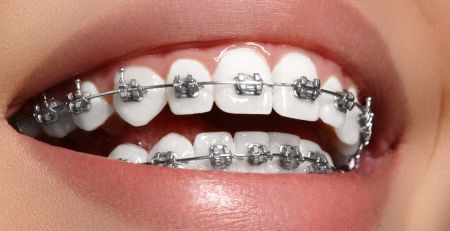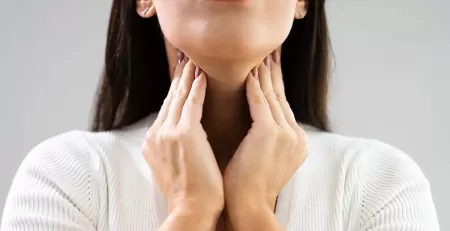Table of Contents
What is Malocclusion?
Malocclusion refers to the misalignment or improper positioning of the teeth when the jaws are closed. It is a term used to describe various types of dental and skeletal irregularities that can affect the bite and appearance of the teeth.
Malocclusion can manifest in different ways, such as overcrowding, spacing issues, crossbite, overbite, underbite, or open bite.
Malocclusion can occur due to a combination of genetic and environmental factors. It can be present from birth or develop over time due to habits like thumb sucking, prolonged pacifier use, or tongue thrusting.
Malocclusion can lead to various dental problems, including difficulty chewing or speaking, uneven tooth wear, increased risk of tooth decay and gum disease, and even jaw joint disorders.
Correcting malocclusion is essential not only for aesthetic reasons but also for improving overall oral health and function.
Orthodontic treatments, such as dental braces, clear aligners, or other dental appliances, can realign teeth and jaws into proper alignment.
Early intervention is often recommended to address malocclusion during childhood or adolescence when the jaw is growing and more responsive to treatment.
It is crucial to consult with a qualified orthodontist or dentist who can assess the severity of malocclusion and recommend the most suitable treatment options.
By addressing malocclusion, individuals can improve their oral health, enhance their smile, and achieve proper dental alignment for optimal function and well-being.
What is an Overbite?
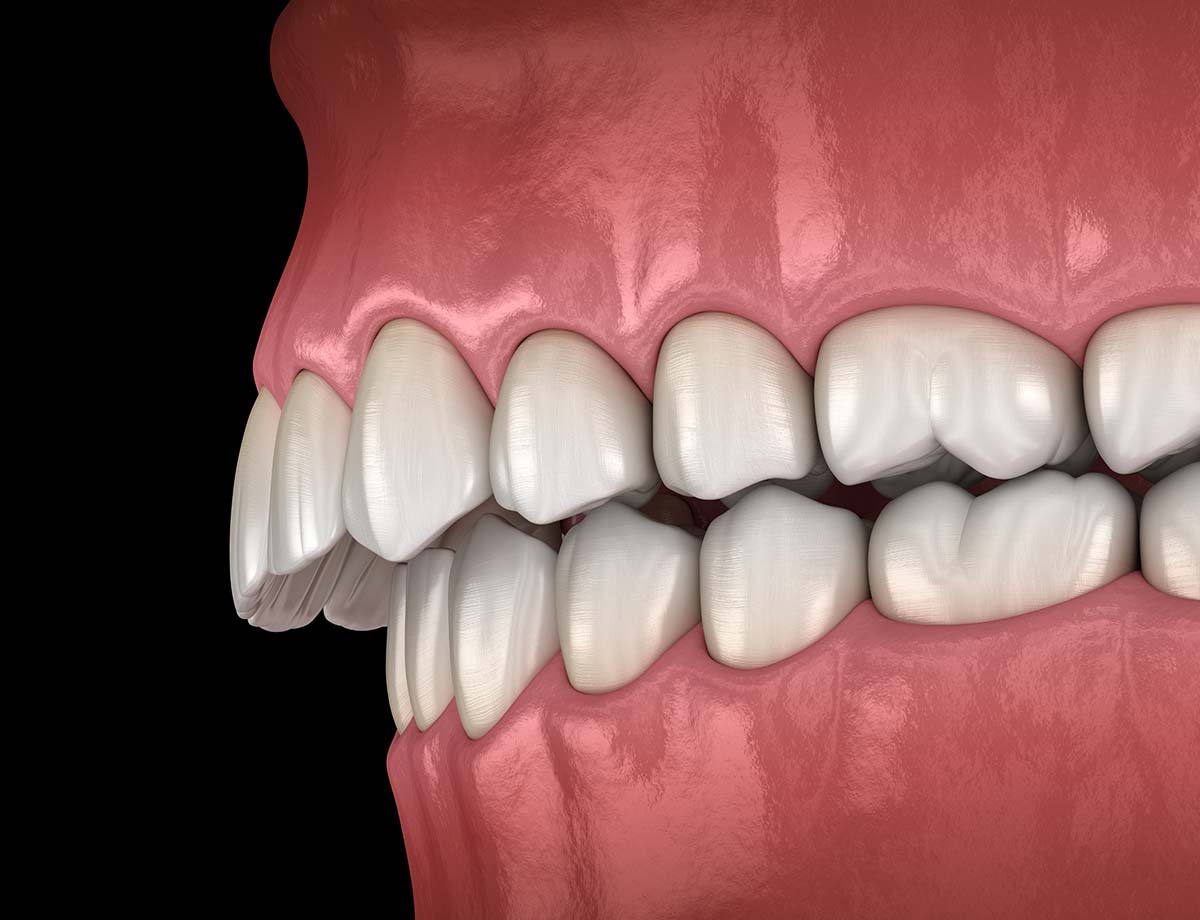
An overbite, a deep bite, represents a specific kind of dental misalignment, malocclusion. This condition is characterised by a significant overlap of the upper front teeth over the lower front teeth when the jaws are closed.
While a slight overlap of the upper teeth over the lower ones is typical in an ideal dental arrangement, an overbite denotes a more pronounced and excessive overlap.
Causes of an Overbite
Various factors can contribute to the emergence of an overbite, but genetic predisposition often plays a crucial role in its development.
Childhood habits such as thumb sucking, extensive pacifier use, and prolonged bottle feeding are also common contributors.
Additionally, abnormal growth and development of the jaws can lead to an overbite.
The size and positioning of the teeth, alongside the interplay between the upper and lower jaws, further influence the likelihood of developing this condition.
Problems Associated with an Overbite
A pronounced overbite extends beyond a mere aesthetic concern and can usher in several complications. These issues include:
Aesthetic Impact
A significant overbite can alter the visual appeal of a smile. It often results in the upper front teeth appearing unduly prominent or protruding, affecting self-esteem and social interactions.
Dental Health Risks
The misalignment characteristic of an overbite complicates maintaining proper oral hygiene. This difficulty can escalate the risk of tooth decay, gum disease, and other oral health problems.
Tooth Wear and Damage
An overbite leads to an uneven overlap of teeth, specifically affecting the lower front teeth that frequently contact the upper teeth during biting and chewing. This situation can result in abnormal wear and potential damage to the tooth enamel.
TMJ Disorders
A severe overbite can contribute to temporomandibular joint disorders (TMJ). The misalignment of the jaws and the strain it places on the jaw joints might lead to discomfort and functional problems in the TMJ area.
Treatment for an overbite depends on its severity and underlying causes. Orthodontic interventions, such as braces or clear aligners, are commonly used to move the teeth gradually into proper alignment.
In some cases, additional treatments like tooth extraction or jaw surgery may be necessary to correct the overbite.
It is essential to consult with a qualified orthodontist or dentist to assess the severity of an overbite and determine the most appropriate treatment plan for achieving a healthy bite and optimal oral health.
What is an Open bite?
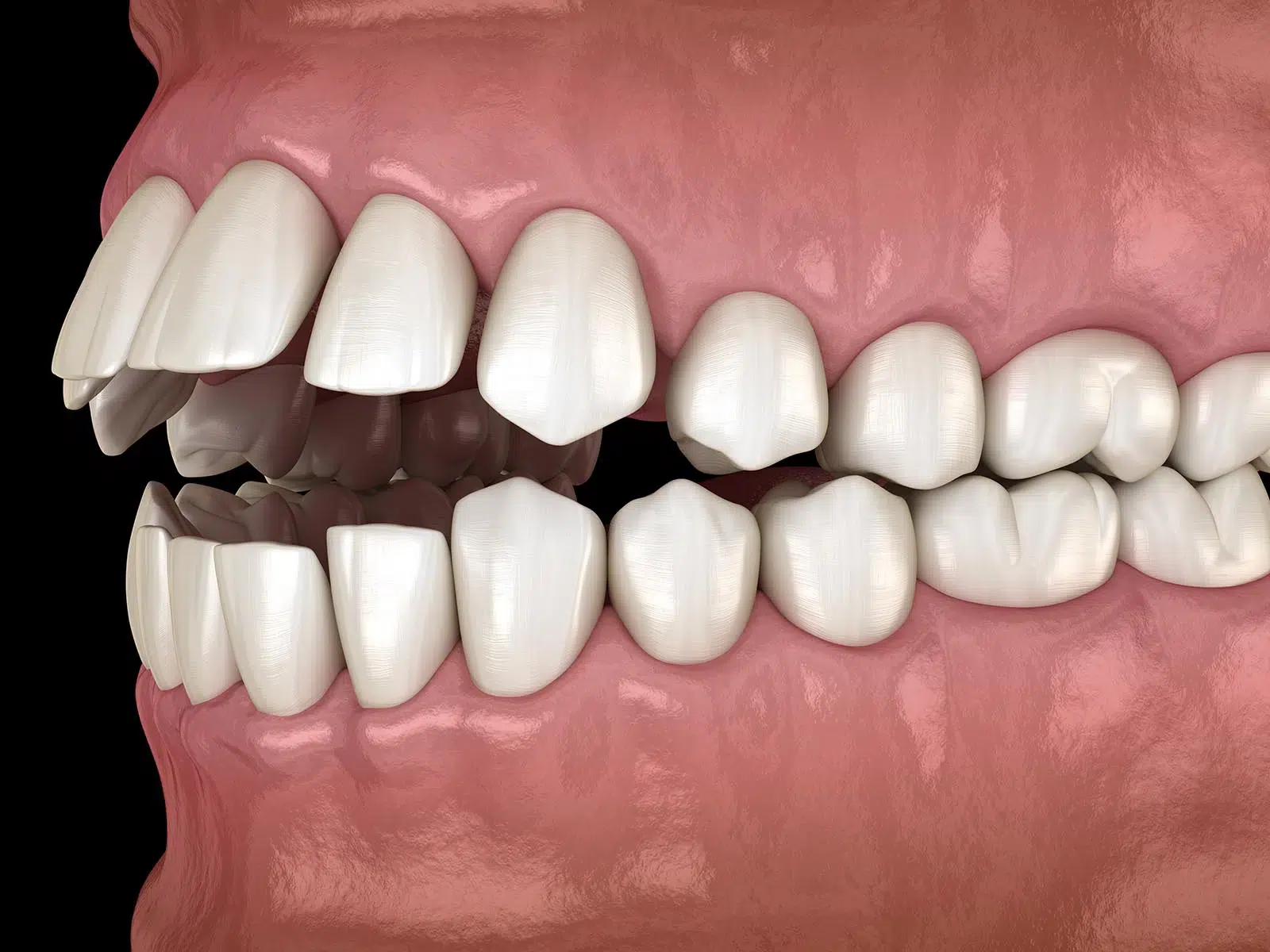
Open bites are dental misalignments characterised by a noticeable gap between the upper and lower teeth when the mouth is closed.
Unlike a normal bite, where the upper and lower teeth should fit together correctly, an open bite occurs when the front teeth fail to contact each other, leaving a visible opening between them.
Causes of an Open Bite
This condition can stem from various factors, each playing a distinct role in its development. Understanding these causes is crucial for effective diagnosis and treatment.
Thumb Sucking or Pacifier Use
One of the most common causes of open bites in children is prolonged and intense thumb sucking or pacifier use.
When a child frequently sucks their thumb or uses a pacifier, it exerts pressure on the front teeth. This pressure can push the front teeth forward, disrupting their natural alignment and leading to an open bite.
The habit’s intensity and duration are critical factors in determining the extent of the dental impact.
Tongue Thrusting
Tongue thrusting, a habitual action where the tongue is pushed against the front teeth during activities like swallowing or speaking, can also lead to an open bite.
Over time, the consistent pressure exerted by the tongue forces the teeth apart, contributing to the gap characteristic of an open bite.
This habit often requires specialised therapy, which involves retraining the muscles in swallowing and speaking.
Jaw Discrepancies
Skeletal issues or discrepancies in the size and position of the jaws are another significant cause of open bites.
Conditions such as a crossbite or an underlying skeletal imbalance can lead to jaw misalignment, which in turn contributes to the formation of an open bite.
These issues often require orthodontic intervention, which may include braces or surgery, depending on the severity of the jaw discrepancy.
Temporomandibular Joint (TMJ) Problems
Finally, open bites can sometimes result from issues related to the temporomandibular joint (TMJ), which connects the jaw to the skull.
TMJ disorders can affect the alignment of the jaws and teeth, leading to an open bite. Addressing the underlying TMJ problems is crucial for resolving the open bite and ensuring oral health.
Implications of Open Bites on Oral Function and Aesthetics
Open bites, characterised by a gap between the upper and lower teeth, can affect oral functionality and aesthetics.
These impacts range from speech difficulties to challenges in eating, increased dental problems, and aesthetic concerns, all of which can significantly affect an individual’s quality of life.
Speech Difficulties
One of the primary consequences of an open bite is its effect on speech.
The misalignment of teeth alters the regular speech pattern, potentially leading to the mispronunciation of certain sounds or words. This is because specific sounds rely on the teeth’s position to be produced correctly.
Speech difficulties can impact communication and, in some cases, may require speech therapy for correction.
Chewing and Eating Difficulties
Another significant impact of an open bite is on chewing and eating.
The gap between the upper and lower teeth can make it challenging to bite and chew food effectively. This difficulty can lead to inadequate food breakdown and subsequent issues with digestion.
It may also limit the types of food one can comfortably eat, affecting nutrition and overall enjoyment of food.
Increased Risk of Dental Problems
An open bite can elevate the risk of various dental issues.
The abnormal alignment often leads to uneven distribution of biting forces, which can cause uneven wear on the teeth. This misalignment can also make maintaining oral hygiene more challenging, increasing the risk of tooth decay and gum disease.
Such dental problems not only affect oral health but can also necessitate extensive dental treatments.
Aesthetic Concerns
Lastly, the visible gap caused by an open bite can impact the aesthetics of one’s smile. This aesthetic issue can lead to self-consciousness or a lack of confidence, especially in social situations.
The appearance of the teeth is a significant factor in overall facial aesthetics.
Thus, an open bite can profoundly affect an individual’s self-image and confidence.
How to Fix an Open Bite? Open Bite Treatment Options
Treatment for an open bite depends on the underlying cause and severity of the condition.
Orthodontic treatment with braces or aligners is often recommended to move the teeth into proper alignment gradually.
In cases where skeletal discrepancies cause the open bite, jaw surgery may be necessary to correct the underlying issue.
Early intervention is crucial for the most successful treatment outcomes, so it is essential to consult with an orthodontist or dentist as soon as an open bite is detected.
Addressing an open bite can improve its function and aesthetics, allowing for better oral health and a more confident smile. It is essential to seek professional advice to determine the most suitable treatment approach for an individual’s situation.
What is an Underbite?
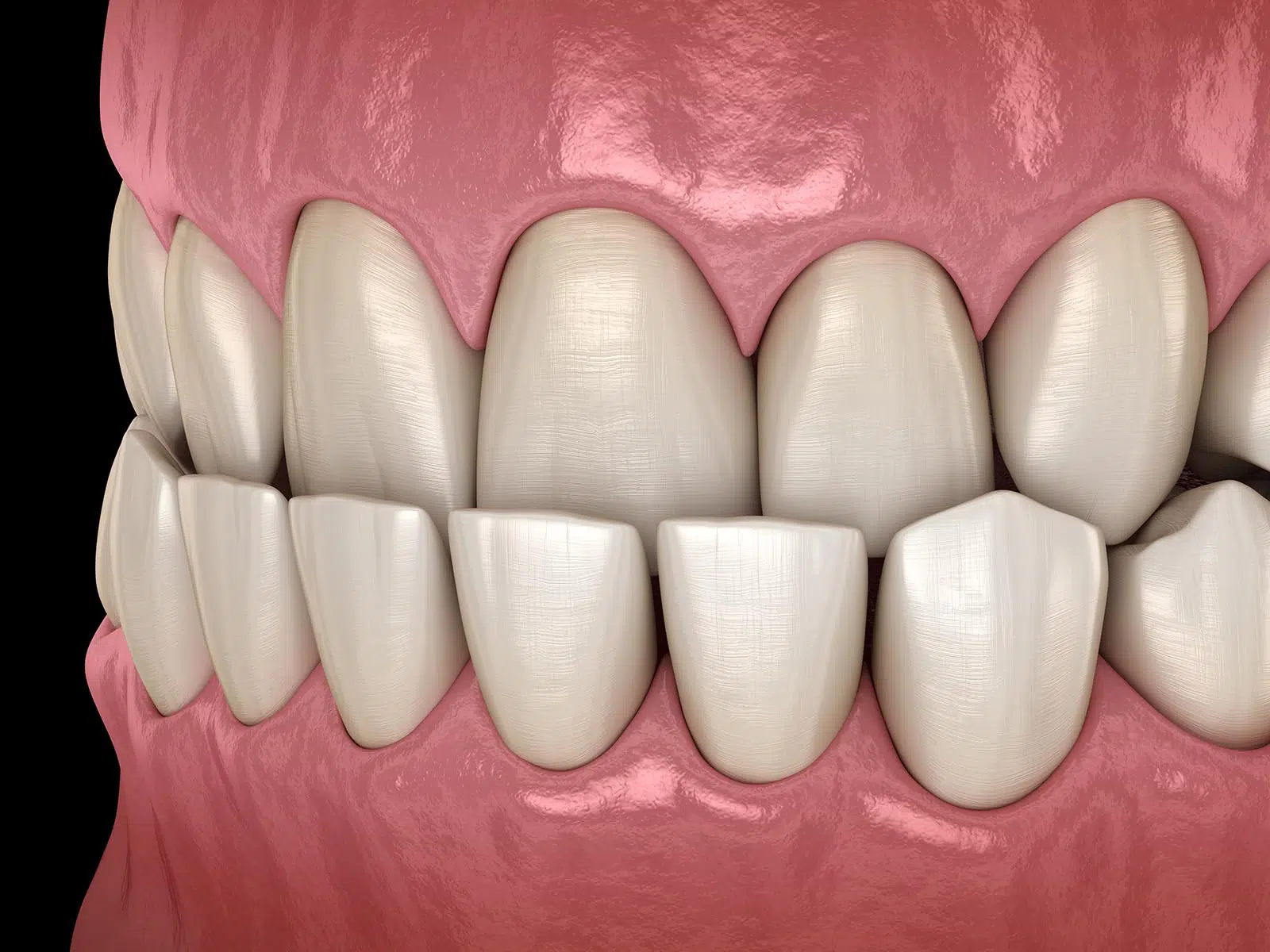
An underbite, a Class III malocclusion or prognathism, is a dental condition where the lower jaw protrudes forward, causing the lower teeth to overlap or cover the upper teeth when the jaws are closed.
In other words, the lower jaw and teeth extend beyond the upper teeth, creating an imbalance in the bite.
Causes of Underbites
Underbites, a condition in which the lower teeth protrude beyond the upper teeth, can be attributed to various factors, from genetic influences to habitual practices.
Understanding these causes is crucial for effective treatment and management.
Jaw and Skeletal Discrepancies
One of the primary reasons for an underbite is the discrepancy in jaw development. This condition can arise when the lower jaw develops excessively or the upper jaw does not fully develop.
Genetic factors often play a significant role in these abnormal growth patterns, which can lead to a misalignment in the jaw structure.
Skeletal discrepancies can significantly impact dental alignment, facial aesthetics, and function.
Impact of Thumb Sucking and Prolonged Pacifier Use
Habits such as thumb sucking or prolonged use of pacifiers in childhood can also contribute to the development of an underbite.
These habits pressure the front teeth, potentially altering their natural growth direction and alignment.
The consistent force applied by these actions can encourage the lower jaw to protrude forward, leading to an underbite.
Addressing these habits early is crucial in preventing long-term dental issues.
Teeth Misalignment
Another factor contributing to underbites is the misalignment or crowding of teeth.
When teeth are misaligned or crowded, they can affect the positioning of the jaws.
Misaligned teeth can push the lower jaw forward, resulting in an underbite. Orthodontic treatments often address this issue by correcting the positioning of the teeth and, consequently, the alignment of the jaws.
Temporomandibular Joint (TMJ) Issues
Problems associated with the temporomandibular joint (TMJ) can also contribute to the development of an underbite.
TMJ issues can affect how the jaw opens and closes, potentially leading to an imbalance in the jaw alignment.
While not the most common cause, TMJ disorders can contribute to the complexity of an underbite and may require specialised treatment to resolve both the TMJ issues and the underbite simultaneously.
Health and Functional Implications of Underbites
Underbites, a dental condition where the lower teeth protrude beyond the upper teeth, can lead to various oral health and functional issues.
Underbite problems can affect everyday activities such as eating and speaking, leading to more serious dental and jaw concerns.
Challenges in Biting and Chewing
One of the most immediate effects of an underbite is the difficulty in adequately biting and chewing food.
Misalignment can make it hard to break down food effectively, potentially leading to digestive problems.
This can also contribute to nutritional deficiencies in the long term, as individuals with underbites might avoid chewing certain problematic foods.
Speech Problems
Underbites can significantly impact speech clarity.
The abnormal positioning of the teeth and jaws can make it difficult to pronounce certain sounds correctly, leading to speech impediments. This can affect communication and may require speech therapy for improvement, especially in severe cases.
Temporomandibular Joint (TMJ) Pain
The improper alignment associated with underbites can strain the temporomandibular joint (TMJ), which connects the jaw to the skull.
Constant strain can manifest as jaw pain, headaches, and other TMJ-related issues.
These symptoms can range from mild discomfort to severe pain, affecting daily life and necessitating medical or dental intervention.
Increased Risk of Tooth Wear and Damage
An underbite also leads to abnormal tooth positioning, causing uneven wear and tear. Consequently, unevenness increases the risk of dental problems such as tooth decay and gum disease.
The excessive wear can damage tooth enamel and may require restorative dental treatments to address the resulting issues.
Regular dental check-ups and appropriate care are essential for managing these risks associated with underbites.
Practical Treatment Strategies for Underbites
The treatment of an underbite is contingent on its severity and underlying causes.
Prompt and early intervention is often key to successful treatment, as it can prevent the condition from worsening over time.
Various treatment options are available, each tailored to the specific needs and severity of the underbite.
Orthodontic Treatment
Orthodontic interventions are a common approach for correcting underbites.
Treatment can be performed with traditional braces or clear aligners, which gradually shift the teeth into proper alignment. The choice between braces and aligners depends on the individual’s case, with braces often more effective for severe misalignments.
Dental braces not only correct the underbite but also improve the overall appearance and functionality of the teeth.
Jaw Surgery
Orthognathic surgery may be recommended in more severe cases where skeletal discrepancies cause the underbite. This surgical procedure involves repositioning the jaws for a balanced and functional bite.
Jaw surgery is often considered when orthodontic treatments are insufficient to correct the underbite. It is a more invasive option but can significantly improve function and appearance.
Use of Dental Appliances in Children
Functional dental appliances, such as headgear or chin caps, can be an effective treatment option for growing children. These appliances are designed to influence the growth and position of the jaws during the developmental stages.
They work by modifying the jaw growth to correct the underbite, often in conjunction with orthodontic treatments. This approach is most effective when started early, as it harnesses the child’s natural growth processes for optimal results.
It is essential to consult with an orthodontist or dentist specialising in treating malocclusions to determine the most suitable treatment approach for an individual’s case.
Early evaluation and intervention can help prevent potential complications and improve the bite’s function and aesthetics.
What is a Crossbite?

A crossbite is a type of dental misalignment where some upper teeth sit inside the lower teeth when the jaws are closed. It is a condition in which the upper teeth are positioned more towards the inside of the mouth than the lower teeth, resulting in a reversed biting relationship.
Crossbites can occur in the front or back of the mouth, affecting a single tooth or multiple teeth. There are two main types of crossbites:
- Anterior Crossbite occurs when one or more upper front teeth are positioned behind the lower front teeth when biting down. It can lead to aesthetic concerns, functional issues, and uneven tooth wear.
- Posterior Crossbite occurs when the upper back teeth (premolars or molars) are positioned inside the lower back teeth on one or both sides of the mouth. It can affect the proper functioning of the teeth, jaw development, and facial symmetry.
Causes of Crossbites
Crossbites, a type of dental misalignment where the upper and lower teeth do not align properly, can be influenced by various factors. These range from genetic predispositions to habitual practices and physical developmental issues.
Identifying the root cause of a crossbite is essential for determining the most effective treatment plan.
Genetic Factors
Genetics play a significant role in the development of crossbites.
Individuals may inherit certain traits, such as the size and shape of the jaw and the positioning of teeth, which predispose them to this condition.
Inherited characteristics can affect how the jaw and teeth develop and align, leading to a crossbite.
Understanding family dental history can be crucial in early diagnosis and intervention.
Abnormal Tooth Eruption
How teeth emerge and settle into their jaw positions can significantly impact the development of a crossbite. If teeth do not erupt in their proper locations, this can lead to misalignment issues.
Abnormal eruptions can be caused by various factors, including overcrowding in the mouth or extra teeth, resulting in the upper and lower teeth not fitting together correctly.
Habitual Influences
Certain habits, particularly in childhood, can contribute to the development of crossbites. Thumb sucking, tongue thrusting, and prolonged use of pacifiers are common examples.
These habits can pressure the teeth and jaws, influencing their growth and alignment.
This can lead to crossbite formation over time, especially if these habits persist beyond the early developmental stages.
Jaw Size and Position Discrepancies
Differences in the size and positioning of the jaws can also lead to crossbites.
A mismatch in the size or alignment of the upper and lower jaws can result in an improper bite. This issue can be due to various factors, including developmental conditions or injuries, and often requires orthodontic intervention to correct.
Impact of Teeth Crowding
Teeth crowding, where there is usually not enough space in the mouth for all the teeth to fit, can affect the alignment of the upper and lower teeth. This crowding can force teeth into incorrect positions, leading to a crossbite.
Crowded teeth contribute to alignment issues and complicate oral hygiene, increasing the risk of dental problems.
Addressing crowding early, often through orthodontic treatment, is key to preventing or correcting a crossbite.
Dental Complications from Crossbites
Treating crossbites is crucial for aligning the teeth properly and preventing a range of related dental and aesthetic issues.
Neglecting to address crossbites can lead to complications that affect oral health, jaw function, and facial appearance.
Prevention of Uneven Tooth Wear
One of the primary concerns with untreated crossbites is uneven tooth wear. This condition can result in excessive wear and tear on certain teeth, leading to tooth damage or even premature loss.
The misalignment causes some teeth to bear more biting force than others, leading to accelerated wear and an increased risk of dental problems like cavities or enamel erosion.
Mitigating TMJ Disorders
Crossbites can also strain the temporomandibular joint (TMJ), which connects the jaw to the skull.
The misalignment associated with crossbites can lead to imbalanced jaw movement, placing undue stress on the TMJ and surrounding muscles. This can contribute to the development of TMJ disorders, characterised by jaw pain, clicking or popping sounds, and difficulty moving the jaw.
Treating crossbites early can help alleviate this strain and prevent TMJ-related problems.
Enhancing Facial Aesthetics
Beyond the functional implications, crossbites can significantly impact the aesthetics of a person’s smile and overall facial symmetry.
The misalignment can make the smile appear uneven and, in some cases, affect the overall balance and symmetry of the face.
Correcting a crossbite can positively affect a person’s facial aesthetics, leading to improved self-confidence and a more harmonious facial appearance.
Aesthetic improvement is essential, especially for individuals self-conscious about their appearance due to their dental alignment.
Dental Treatment Approaches for Crossbites
The treatment of crossbites is highly dependent on their severity and the root causes behind their development.
A range of treatment options is available, each tailored to address specific aspects of this dental misalignment.
Orthodontic Solutions
Orthodontic treatment plays a pivotal role in correcting crossbites. This category includes braces and other specialised orthodontic appliances designed to gradually shift teeth into their correct positions.
The type of orthodontic appliance used is determined based on the individual’s specific dental needs.
The goal is to align the teeth properly, ensuring the upper and lower teeth fit together correctly. This treatment not only rectifies the crossbite but also improves the patient’s overall dental health and aesthetics.
Use of Palatal Expanders
Palatal expanders are another effective treatment option, particularly beneficial in cases where the crossbite is due to a narrow upper jaw.
These devices work by gradually widening the upper jaw, creating more space for the teeth to align correctly. This approach is often used in younger patients, taking advantage of their still-developing jawbones, which are more amenable to reshaping.
Expanding the upper jaw can significantly contribute to correcting certain types of crossbites and can be a crucial step in comprehensive orthodontic treatment.
Dental Restorations for Crossbite Correction
In some instances, dental restorations like crowns or veneers may enhance the appearance and function of teeth affected by a crossbite.
These restorations are custom-made to fit over the existing teeth, improving their shape, size, and overall appearance.
While this approach may not address the root cause of the crossbite, it can significantly improve aesthetics and dental function, especially in cases where the teeth have suffered damage or wear due to the misalignment.
Dental restorations are typically considered when orthodontic treatments are insufficient or the patient desires a quicker cosmetic solution.
Early intervention is important in correcting crossbites, especially during childhood when the jaw is still developing.
Orthodontists and dentists with expertise in malocclusions can evaluate the situation and recommend the most suitable treatment approach.
Correcting crossbites can improve oral function, enhance aesthetics, and contribute to overall dental health.
Dentists may combine different cosmetic dental treatments to achieve optimum aesthetic results.

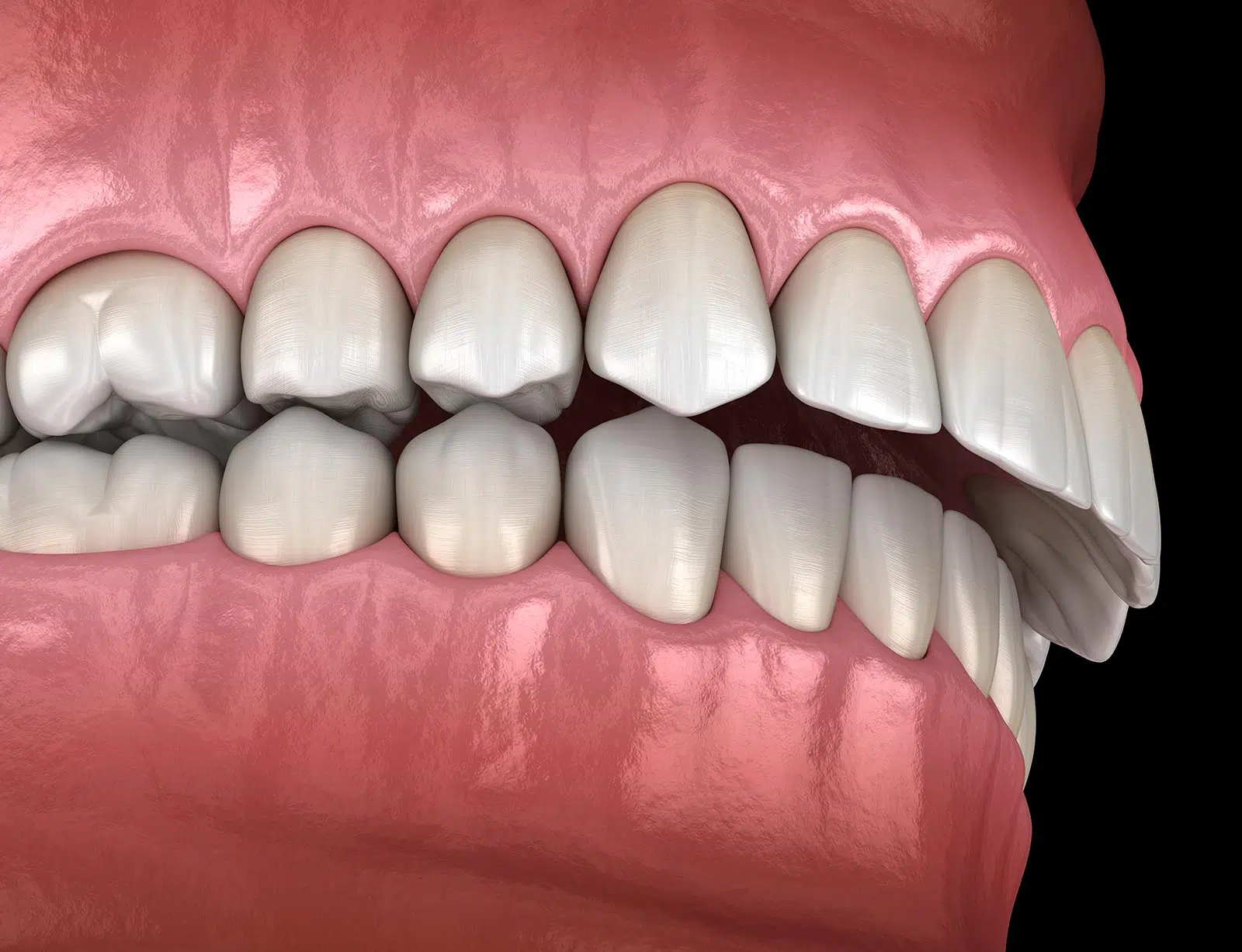
![[BRACES EXPLAINED] Elastics / Rubber Bands](https://amazingsmiles.com.au/wp-content/cache/flying-press/5264c217769b5e4b6cfba772100765e2.jpg)
